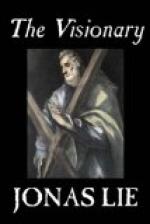I was strictly forbidden by my father to go into the servants’ hall in the evening; he knew very well that a good many things were said there that were not fit for children’s ears. But then, on the other hand, it was just down there that the most interesting things in the world were talked about. The consequence was that I used to steal down secretly. I remember how, one dark autumn evening, when I had slipped in, I listened, while Komag-Nils—the man with the yellow hair and death’s-head grin when he laughed—told a dreadful ghost story from Erlandsen’s predecessor’s time.
At that time there stood an old store-house not far from the parsonage. One Christmas Eve they sat drinking and merry-making in the warehouse. At eleven o’clock the ale gave out, and a man named Rasmus, who was a strong, courageous fellow, was sent to the store-house, where the beer-cask lay, to fill a large pewter jug, which he took with him. When he got there, Rasmus set the lantern on the cask, and began to draw. When the jug was full, and he was just meditating putting it to his lips, he saw, over the beer barrel, lying with its body in the shadow, where all the barrels stood in a row, a terribly big, broad, dark form, from which there came an icy breath, as if from a door that stood open; it blinked at him with two great eyes like dull, horn lanterns, and said: “A thief at the Christmas ale”! But Rasmus did not neglect his opportunity. He flung the heavy jug right in the goblin’s face, and ran away as fast as his legs would carry him. Outside there was moonlight on the snow; he heard cries and howls down on the shore, and became aware that goblins were pursuing him in ever-increasing numbers. When he came to the churchyard wall they were close upon him, and in his extremity he bethought himself of shouting over the wall: “Help me now, all ye dead!” for the dead are enemies of the goblins. He heard them all rising, and noises and yells as of a battle followed. He himself was closely pursued by a goblin, who was just on the point of springing upon him as he seized the latch of the door, and got safely in. But then he fell fainting on the floor. The next day—the first Christmas Day [In Norway, Christmas Day is called “first Christmas Day”; the day after, “second Christmas Day,” and so on to the end of the week.]—the people going to church saw, strewn all around on the graves, pieces of coffin-boards, and all kinds of old sodden oars, and such timbers as usually sink to the bottom after a shipwreck. They were the weapons that the dead and the goblins had used, and from various things it could be gathered that the dead were the victors. They also found both the pewter jug and the lantern down in the store-house. The pewter jug had been beaten flat against the goblin’s skull, and the goblin had smashed the lantern when Rasmus escaped.




